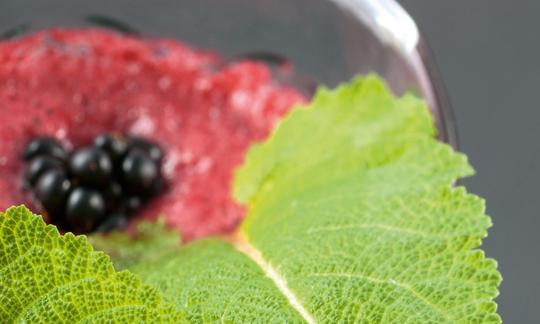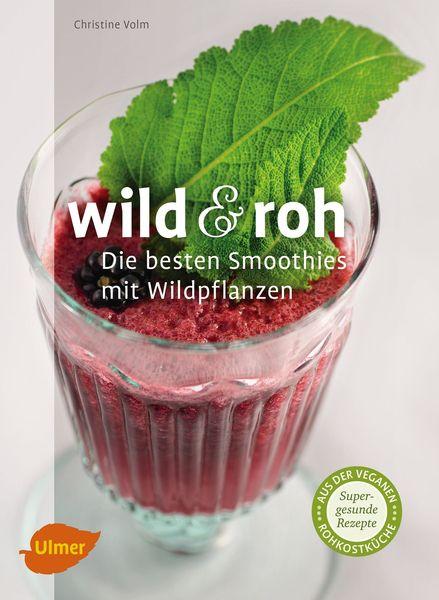Apple, Blackberry, and Meadow Sage Smoothie
raw-vegan
Ingredients (for servings, )
| For the smoothie | |
|---|---|
| 2 | Apples, raw, with peel (11 oz) |
| ⅓ oz | Sage, meadow sage, raw (organic?) |
| 2 ⅛ oz | Blackberries, raw (blackberries, rubus, organic?) |
Equipment
- blender or hand-held blender / immersion blender
Type of preparation
- food preparation without heating
- purée
Preparation
For the meadow sage smoothie
Remove the apple stems and cores and puree together with the sage leaves and the blackberries in a blender. Add enough water to create a smooth, even consistency but be careful not to add so much water that the smoothie becomes too runny.The amount of water you should add depends on the type of apple that you use. Ideally, a good smoothie should be drinkable but not too watery. We recommend using sweet, somewhat soft apples.
For the blackberry leaves, the author Christine Volm suggests using approximately two handfuls for two servings. You can adjust the amount of leaves you use depending on how intense you want the flavor to be. Depending on where you live, meadow sage may be hard to come by. You can substitute it with common sage (garden sage) if desired. If you use common sage, you should reduce the quantity as it tends to have a stronger flavor.
Garnishing and serving
For an aesthetically pleasing drink, serve the smoothies in matching glasses and garnish with a meadow sage leaf and a blackberry, just like on the front cover of the cookbook.
|
Nutritional Information per person
Convert per 100g
|
2000 kcal | |
|---|---|---|
| Energy | 94 kcal | 4.7% |
| Fat/Lipids | 0.50 g | 0.7% |
| Saturated Fats | 0.10 g | 0.5% |
| Carbohydrates (inc.dietary fiber) | 24 g | 8.9% |
| Sugars | 17 g | 19.3% |
| Fiber | 5.3 g | 21.3% |
| Protein/Albumin | 0.89 g | 1.8% |
| Cooking Salt (Na:1.9 mg) | 4.8 mg | 0.2% |
| Essential micronutrients with the highest proportions | per person | 2000 kcal | |
|---|---|---|---|
| Min | Manganese, Mn | 0.45 mg | 22.0% |
| Vit | Vitamin C (ascorbic acid) | 13 mg | 17.0% |
| Vit | Vitamin B7 (Biotin, ex vitamin H) | 7.5 µg | 15.0% |
| Vit | Vitamin K | 9.2 µg | 12.0% |
| Elem | Potassium, K | 218 mg | 11.0% |
| Min | Copper, Cu | 0.10 mg | 10.0% |
| Vit | Vitamin B9, B11 (Folate, as the active form of folic acid) | 12 µg | 6.0% |
| Elem | Magnesium, Mg | 17 mg | 5.0% |
| Vit | Vitamin B6 (pyridoxine) | 0.07 mg | 5.0% |
| Vit | Vitamin E, as a-TEs | 0.62 mg | 5.0% |
Detailed Nutritional Information per Person for this Recipe
The majority of the nutritional information comes from the USDA (US Department of Agriculture). This means that the information for natural products is often incomplete or only given within broader categories, whereas in most cases products made from these have more complete information displayed.
If we take flaxseed, for example, the important essential amino acid ALA (omega-3) is only included in an overarching category whereas for flaxseed oil ALA is listed specifically. In time, we will be able to change this, but it will require a lot of work. An “i” appears behind ingredients that have been adjusted and an explanation appears when you hover over this symbol.
For Erb Muesli, the original calculations resulted in 48 % of the daily requirement of ALA — but with the correction, we see that the muesli actually covers >100 % of the necessary recommendation for the omega-3 fatty acid ALA. Our goal is to eventually be able to compare the nutritional value of our recipes with those that are used in conventional western lifestyles.
| Essential fatty acids | per person | 2000 kcal |
|---|---|---|
| Alpha-Linolenic acid; ALA; 18:3 omega-3 | 0.05 g | 3.0% |
| Linoleic acid; LA; 18:2 omega-6 | 0.12 g | 1.0% |
| Essential amino acids | per person | 2000 kcal |
|---|---|---|
| Tryptophan (Trp, W) | 0.00 g | 1.0% |
| Threonine (Thr, T, irreversibly transaminated) | 0.01 g | 1.0% |
| Isoleucine (Ile, I) | 0.01 g | 1.0% |
| Leucine (Leu, L) | 0.03 g | 1.0% |
| Lysine (Lys, K, irreversibly transaminated) | 0.02 g | 1.0% |
| Phenylalanine (Phe, F) | 0.01 g | 1.0% |
| Valin (Val, V) | 0.02 g | 1.0% |
| Methionine (Met, M) | 0.00 g | < 0.1% |
| Vitamins | per person | 2000 kcal |
|---|---|---|
| Vitamin C (ascorbic acid) | 13 mg | 17.0% |
| Vitamin B7 (Biotin, ex vitamin H) | 7.5 µg | 15.0% |
| Vitamin K | 9.2 µg | 12.0% |
| Vitamin B9, B11 (Folate, as the active form of folic acid) | 12 µg | 6.0% |
| Vitamin B6 (pyridoxine) | 0.07 mg | 5.0% |
| Vitamin E, as a-TEs | 0.62 mg | 5.0% |
| Vitamin B2 (Riboflavin) | 0.05 mg | 4.0% |
| Vitamin B1 (Thiamine) | 0.04 mg | 3.0% |
| Vitamin B5 (Pantothenic acid) | 0.17 mg | 3.0% |
| Vitamin B3 (Niacin) | 0.40 mg | 2.0% |
| Vitamin A, as RAE | 13 µg | 2.0% |
| Essential macroelements (macronutrients) | per person | 2000 kcal |
|---|---|---|
| Potassium, K | 218 mg | 11.0% |
| Magnesium, Mg | 17 mg | 5.0% |
| Calcium, Ca | 31 mg | 4.0% |
| Phosphorus, P | 24 mg | 3.0% |
| Sodium, Na | 1.9 mg | < 0.1% |
| Essential trace elements (micronutrients) | per person | 2000 kcal |
|---|---|---|
| Manganese, Mn | 0.45 mg | 22.0% |
| Copper, Cu | 0.10 mg | 10.0% |
| Iron, Fe | 0.59 mg | 4.0% |
| Zinc, Zn | 0.26 mg | 3.0% |
| Iod, I (Jod, J) | 1.2 µg | 1.0% |
| Fluorine, F | 8.2 µg | < 0.1% |
| Selenium, Se | 0.12 µg | < 0.1% |
In "wild & raw - The best smoothies with wild plants," Christine Volm presents sophisticated creations with wild plants and added health benefits.
Since this book is written in German, a description is omitted here. If you are interested, please switch to German in the menu.
This apple, blackberry, and meadow sage smoothie is fruity and refreshing. The meadow sage gives it a delicious flavor.
Meadow sage: There are several hundred species in the sage genus. Meadow sage differs from standard sage in that it has a less intense flavor when used in cooking and that it does not grow to be very tall. Sage is particularly popular in Italian cuisine. In addition to sage leaves, sage flowers can also be used in cooking. The leaves vary in color from green and yellow to marbled white and violet. Sage is said to help digest fatty foods and can reduce flatulence. It can also be added to cold, refreshing drinks like lemonade.
Blackberries: Blackberries are in the rose family and are an aggregate accessory fruit, not a botanical berry. They are usually dark blue or black when ripe and can be eaten fresh. Blackberries are not only refreshing ingredients for fruit salads and desserts, they are also used to make jams, chutneys, and compote. Blackberries contain both soluble and insoluble fiber. They are also rich in antioxidants.
Blackberry leaves: Ideally, blackberry leaves should be picked in the first half of May. They are tasty and are often used in teas. The leaves contain astringent tanning agents and are used in medicine to treat diarrhea and inflamed or damaged mucous membranes, for example, inflamed gums and throat.
Author’s tip for a healthy topping: If you would like, you can top this smoothie with dried schisandra, also known as magnolia berries and five-flavor-fruits. These berries come from the Schisandra chinensis: a woody vine plant native to northern China, and are considered by many to be a superfood. Simply crush some berries using a mortar and pestle and sprinkle them on the finished smoothie (or stir them in).
You can also grow schisandra plants yourself. If you own a schisandra plant, you can add a few fresh berries to the smoothie. The fresh berries are known for having five flavors: sweet, salty, bitter, pungent, and sour. In Chinese medicine, they are among the most effective remedies for a long, healthy life. Schisandra is an adaptogen: a plant that helps our body to resist stress, and it has strengthening, regenerating, and performance-enhancing effects.
Substitute for meadow sage: Are you having trouble finding meadow sage? If so, you can substitute it with common sage (garden sage). Bear in mind, however, that common sage has a stronger flavor, so you should use a smaller amount.
Suggestions for alternative preparation from the author Christine Volm:
– Spicy applesauce: You can easily use this recipe to make a light and frothy-spiced applesauce. Simply add an additional two apples, a pinch of cinnamon, and a dash of lemon juice, and don’t use water like in the original recipe.
– Give your smoothie a velvety texture: You can also juice the ingredients together in a slow juicer for an even smoother, juicier smoothie.




